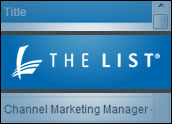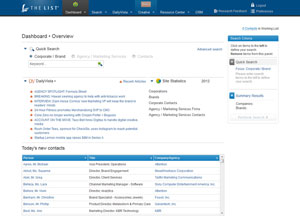
The List, a provider of lead generation software for media buyers and marketers, is adding CRM functionality to its line of services. This new feature set joins other new functions the company is building into its core product, such as integration with Moat.com, and a global media content database.
But do not be fooled into thinking that the CRM function in The List is anything other than a tool for users.
The List CRM, in short, is there to help users manage and track prospects that are generated from the system’s crown jewels or raison d’etre — its corporate and agency contact database. Hence the company’s decision to white label the SugarCRM platform instead of building out its own product.
“Our core business is providing detailed information to media buyers and sellers about who works on which brand and how to get in touch with these people,” Dave Currie, chief marketing officer, told CRM Buyer. “Our CRM system is there for users to manage that sales process.”
The Specific Needs of Media Buyers, Marketers
The List, a 17-year-old company, focuses on a very specific vertical with very distinct needs. It works with both the buy side — that is, network agencies — and the sell side, namely companies that have media properties to sell. This latter group can range from Google to Facebook to Viacom to MTV to Nike to sports teams and arenas.
“Anyone, in short, who has a digital ad they want to place online,” Currie said.
The company’s sales intelligence is very detailed, he continued. A typical record in The List will have the full name and title of a contact, plus hierarchy in the company, email address, LinkedIn profile, and direct dial phone number, and often an assistant’s name and contact information, a bio, and most importantly, brand responsibilities.
“That is what is most important to our users — which people have decision-making authority over which brands,” Currie said.
Other features will show how much Nike spends on print and media campaigns across various media and categories.
One of the industry’s biggest challenges, Currie said, is the low accuracy rate of such data. “There has been a huge drive towards the commoditization of contact data in this market, and the result has been that senior level executives find themselves wading through garbage.”
Building a Comprehensive Record
To build that record, The List has integrated or is integrating with a number of different databases and information sources. LinkedIn, obviously, is part of the mix.
In June, The List added Moat.com — a search engine and analytics platform for online digital ads — to the information sources with which it integrates.
“Moat.com has been getting a lot of traction in this space,” Currie said. “It is a hot commodity in the ad space right now.”
Moat.com’s integration is very relevant for media planners and buyers because they can see in real time which ads are running online at the moment for a particular brand — Nike, for example. The List has also integrated with a global media database that provides creative for TV, radio and other ad channels.
The CRM Role
With CRM in the process of being integrated, users will be able to search and work new business prospects in the same application. “You can seamlessly import a contact directly into the CRM app,” Currie said.
The company chose to white label SugarCRM because it had a positive experience using it internally, Currie said. It is also easily customizable for a vertical such as media buying.
For instance, The List CRM has taken a number of the steps found in traditional CRM applications and consolidated them into a shortened process that is more user-friendly to the advertising-marketing space, Currie said. “We wanted to build something that was intuitive to use and one we could easily support.”
A Strong OEM Base
It is not surprising that The List went with SugarCRM, Nucleus Research Vice President Rebecca Wettemann told CRM Buyer.
“Sugar has always had a strong OEM base. It is natural a company looking to develop a targeted application would turn to Sugar,” she said.
Now that the on-demand vendor is partnering with IBM, she added, she expects to see more such white label applications come to market.
“Companies developing micro-verticals are not interested in building elaborate workflows or reporting capabilities,” Wettemann said. “Rather, they just want to know they have a solid platform and database so they can concentrate on their core differentiation.”
























































Social CRM
See all Social CRM